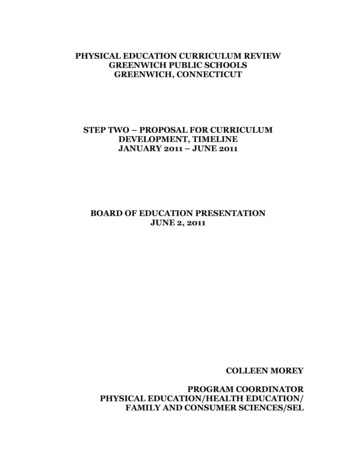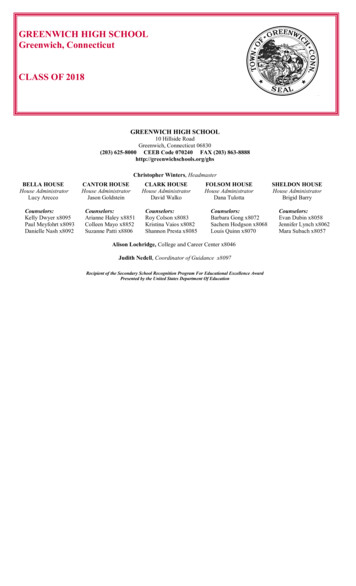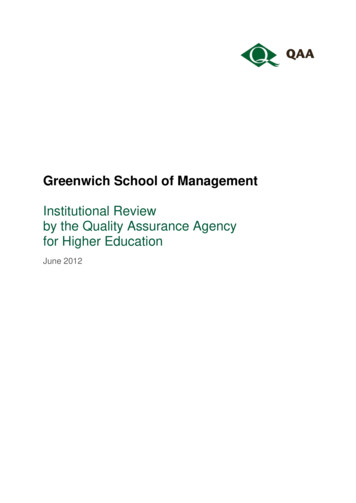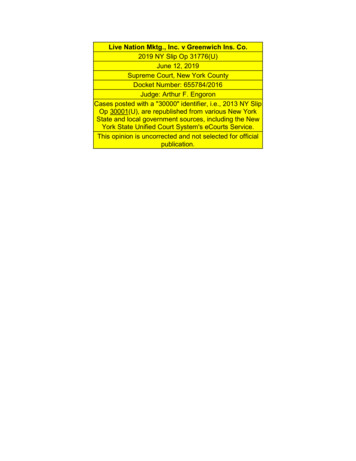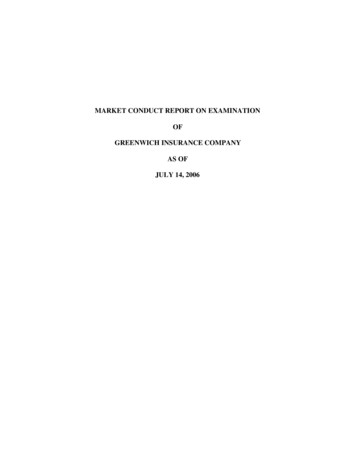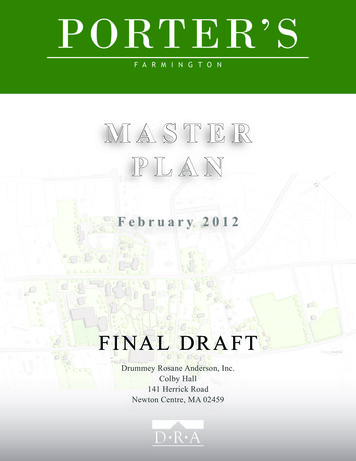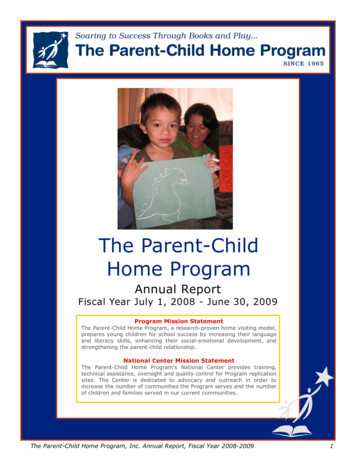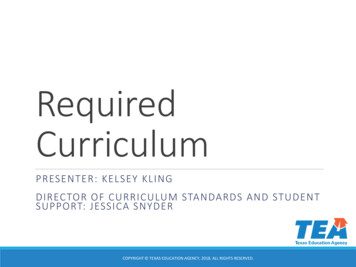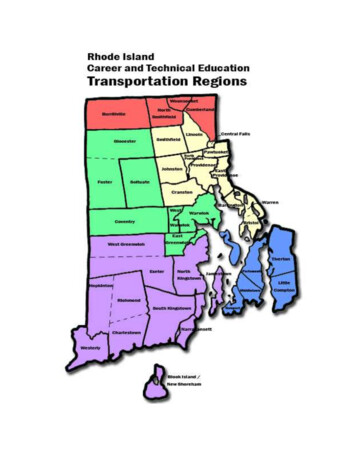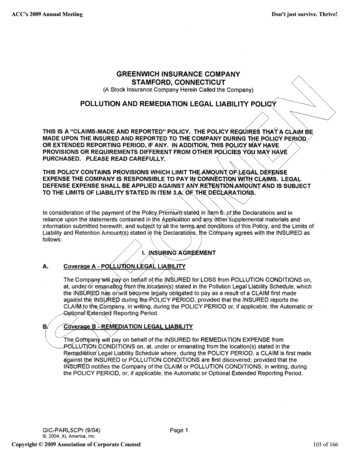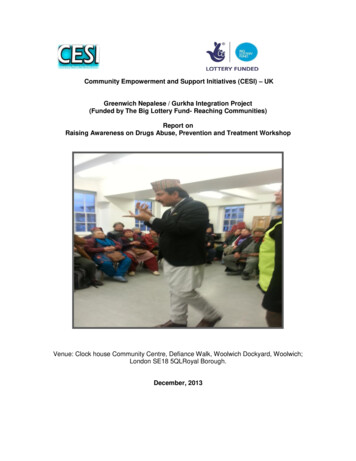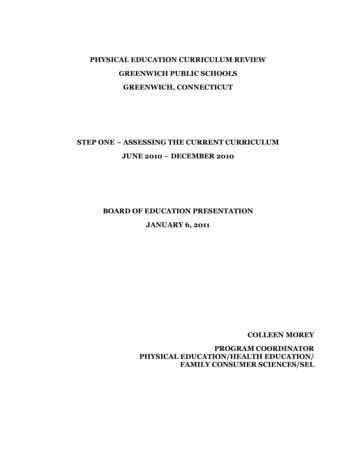
Transcription
PHYSICAL EDUCATION CURRICULUM REVIEWGREENWICH PUBLIC SCHOOLSGREENWICH, CONNECTICUTSTEP ONE – ASSESSING THE CURRENT CURRICULUMJUNE 2010 – DECEMBER 2010BOARD OF EDUCATION PRESENTATIONJANUARY 6, 2011COLLEEN MOREYPROGRAM COORDINATORPHYSICAL EDUCATION/HEALTH EDUCATION/FAMILY CONSUMER SCIENCES/SEL
PHYSICAL EDUCATION CURRICULUM REVIEW2010-2012Executive SummaryHistory – The development of current practices since 2001Current PracticesCurriculum Review 2010-2012Assessing the CurriculumMembers of the Review TeamConsultant ServicesMeeting DatesDescription of the Data Collection ProcessAppendix A1Content Articulation Grades K-10Appendix A2Content Articulation Grades 11-12Appendix BPhysical Fitness Content Articulation Grades K-10Appendix CConnecticut State Physical Fitness Test Results 1999-2010Appendix DProfessional Learning Programs and Courses 2000-2010Appendix E1Elementary School Year End Student Achievement ResultsAppendix E2Middle School Year End Student Achievement ResultsAppendix FStudent and Parent Focus Group Findings, November 2010Appendix G1Best Practices Data – ElementaryAppendix G2Best Practices Data – Middle SchoolAppendix G3Best Practices Data – High School
2010 EXECUTIVE SUMMARYSTEP ONE – PHYSICAL EDUCATION CURRICULUM REVIEWHistory – Deficiencies Cited in 2001 Curriculum ReviewCurriculum –FitnessArticulationAssessmentProfessional learning –InclusionDifferentiationCommunication –Assessment reportedReport card rubricsSite based newsletters/announcements/coffeesResponse to Deficiencies Since 2001 –Curriculum Enhanced Fitness – k-12 all classes, all schools, all yearContent Articulation – vertically and horizontally articulatedwith 12 sports/activities identified at specified gradelevels, are delivered developmentally such thatstudents learn a wide range of skills and knowledgefor transfer to a wider range of lifetime fitness, sportand recreational pursuits. These sports and activitiesare complemented by additional sports and activitiessuch that all instructional objectives in each gradelevel are learned through the course of each schoolyear.Assessment – Assessments and rubric indicators administeredspecific to each of the objectives have been identifiedfor enduring understanding in each grade level.Students are assessed formatively and summatively.Due to the developmental nature of the curriculum,students move along the continuum of the rubricspectrum through each grade level school year oruntil mastery is attained. Students identified asneeding support to attain proficiency are scheduledinto remediation sessions where they receivesupplemental instructional time specific to their areaof deficiency.
Report cards reflect motor skill achievement, learningconcept (knowledge) achievement, fitnessachievement and social responsibility.Professional learning – Provided on a regular, rigorous basis throughProgram meetings and other designated meeting days- specific to differentiation, inclusion, instructionalfitness strategies, and technology.Communication - Informal correspondence with parents via weeklynewsletters, special event and program highlightnewsletters, and websites.Formal communications via kindergarten screening letters,trimester/quarterly report cards, progress reports,and conferences as requestedCurrent Gaps/Challenges for Greenwich Public SchoolsLearning Environment:Safety - Internal disinfecting practicesFacility –Multiple gymnasiums - only at GHSFitness centers – only at GHS and EMSAdventure courses – indoor and outdoor – only at selected schoolsPools – only at GHSDance Studios – only at GHSSufficient storageField space sufficient, diverse, consistentLocker rooms – only at GHS and EMSTennis courts – not at elementary schoolsTrack – only at GHSTechnology equipped gymnasium and fitness centersAccess to bathrooms and water – not at all schoolsEquipment –Consistency across district – specific to Fitness CentersCurriculum:Incorporates trans-disciplinary instructionIncremental capstone projects/programsAssured experiences by grade level – only at 4th and 5th grades21st century content areasTechnology incorporated regularly into instructional program – inconsistentAdditional RTI Tier Three strategies required to meet the instructional needs ofextreme case situations2010 Data reveals a need to review and address inconsistencies in the StateFitness Test results by school (Hamilton Avenue School, Eastern Middle School,North Mianus School).
Assessment:Incorporates use of technology for record keeping/management of assessments –need more consistencyTechnology used to assist students in goal setting for health-related fitnessimprovement and self-assessment – need more consistencyProfessionalism:Staff utilizes 21st century instructional practices with studentsCertification – Restraining training, Concussion training, Lifeguard trainingTeachers practice trans-disciplinary instructionTeachers are current in, and apply technology - inconsistentCelebrationsLearning Environment:Safety –Regular inspections and maintenanceFacility –Multiple Gymnasiums –GHSFitness center – GHS and EMSAdventure courses – indoor and outdoor – selected schoolsPool – GHSDance Studio – GHSField space sufficient, diverse, consistentLocker rooms – GHS and EMSTennis courts – middle and high schoolsTrack - GHSEquipment –Ample equipment for all students in all classes – age appropriateAdequate budget for purchase and maintenanceCurriculum:Based on each of the National StandardsArticulated vertically and horizontallyAssured experiences by grade level – grades 4 and 5Wide range of age appropriate content areasIncorporates wellness approach to instructionTechnology incorporated regularly into instructional programRTI Tier One strategies are well-developed: numerous students are included andprovided with extensive differentiated learning opportunitiesAssessment:Based on objectives identified within each National StandardAssessment of SEL skillsIncorporates use of technology for record keeping/management of assessments
Technology used to assist students in goal setting for health-related fitnessimprovement and self-assessmentReporting practices – students, parents, communityRegular monitoring reports/reviewsProfessionalism:Opportunities for conference/workshop attendanceIn-house professional learning provided on a regular basisCertification – First Aid, CPR, Concussion training, Fitness Center CertificationDesignated district coordinatorTeachers are current in, and apply technology – varies widely by teacherNext StepsMembers of the Physical Education Department curriculum review team willconvene regularly scheduled work sessions to prioritize areas of deficiency in curriculumand develop an action plan, timeline and budget for addressing the gaps. Capstoneprojects similar to the 5th Grade Orienteering Meet will be developed for incrementalgrade levels (to be identified). Program development will focus on trans-disciplinaryunits, mini-courses and electives opportunities, improved and consistent technologyinfusion, peer mentoring, family and community connections, youth wellness and 21stcentury instruction. Additionally, curriculum development will address thediscrepancies in fitness scores from school to school, particularly the lower State FitnessScores from the 2010 Assessment in North Mianus School, Hamilton Avenue School,and Eastern Middle School. The issues identified by participants in the parent andstudent focus groups will also be targeted through professional learning, TEPLstrategies, and program development as appropriate. Proposals will be developed forprogramming beyond the school day as well as for remedial/supplemental programmingwithin the school day, and considerations for alternative scheduling based on studentneeds assessments will be recommended. The recommendations for programdevelopment will be presented to the Board of Education on June 2, 2011 and willinclude parent and student input, exploration of professional learning needs, andbudgetary implications.
Curriculum Review – Greenwich Public Schools Physical EducationHISTORY - Development of current practicesThe BOE curriculum review, conducted in 2000-2001, identified severalrecommendations:Curriculumo Improve and expand the physical fitness program, k-12o Provide specific content for grade levels to ensure less repetition andgreater variety of activitieso Ensure articulation of the program k-12, across all schools relating tocontent (sports and activities through which objectives are delivered)o Review of existing assessments and development of new assessmentswhere appropriateProfessional Learningo Plan professional learning designed to improve instruction toaccommodate all learners, including remediation and acceleration forthose as neededCommunicationo Improve communication with parents regarding student progress andachievement in physical educationCURRENT PRACTICES since 2000-2001 ReviewCurriculum – content and articulation modelThe Greenwich Public Schools Physical Education curriculum is based on NationalStandards, State Standards and Best Practices, and is articulated both vertically throughthe grade levels and horizontally across the schools. Using the Understanding byDesign (heretofore referenced as UbD) backwards design model of curriculumdevelopment, student objectives for enduring understanding are identified by gradelevel, beginning with defining the Vision of the Physically Educated Graduate andtracking backward to include the essential learning needed to achieve this desired endproduct. The objectives are developmentally appropriate and delivered through arigorous differentiated approach to instruction. Within each grade level, designatedsports and activities have been identified through which students learn motor skills,learning concepts and strategies, fitness, and social responsibility. The K – 10 contentarticulation is such that, upon completing the tenth grade, students have developedproficiency in thirteen different sports and activities, the skills and concepts of whichare transferrable to a wide range of sport, fitness, and lifetime activity pursuits. Theeleventh and twelfth grade programs include a wide range of elective sports, activities
and certification courses, thus enabling students to apply and transfer previouslylearned skills and knowledge for engagement in personally desirable activities for bothrecreation and vocation. (Appendix A1 and Appendix A2– Content Articulation Charts)Enhanced FitnessAt the time of the first curriculum review, in 2000-2001, 39% of the students in gradesfour, six, eight and ten who participated in the State of Connecticut Fitness studentfitness achievement passed the test on four out of four test items. This district scoreprompted the identification of fitness as a primary program goal. During the next tenyears, fitness was rigorously addressed through a wide range of activity andmotivational modalities. (Appendix B– Physical Fitness Content Articulation)Fitness is rigorously taught and practiced in all grades, in all classes, throughout theentire school year. Beginning in 2001 with an aggressive infusion of functional fitnesstraining, using the expertise of GHS staff and George Marom (former CzechoslovakianOlympic Strength Training Coach), PE teachers have participated in professionallearning using medicine balls (sets of which were purchased for every school), strategiesfor achieving fitness through adventure, achieving fitness through sport, and addressingchildhood obesity through activities and adaptations. Teachers incorporate pedometers,heart rate monitors, and the TRI-FIT SYSTEM (a computerized fitness assessmentproduct manufactured by Polar, Inc.) into their instructional program to motivate anddocument student achievement in cardio-respiratory fitness pursuits.The 2009 State of Connecticut Fitness achievement results for students in grades four,six, eight, and ten indicated that 69.94% of the students passed four out of four testitems, an increase of 30%. Ranking for the Greenwich Public School District over athree-year period within the State of Connecticut School Districts was as follows:2006-2007: 23rd out of 186 school districts2007-2008: 22nd out of 187 school districts2008-2009: 38th out of 190 school districts(Appendix C – Connecticut State Physical Fitness Test Results 1999-2010)Professional LearningProfessional Learning focuses on differentiated instructional practices to improvestudent achievement. An annual goal of the physical education program improvementis rigorous technology infusion, which has formed a foundation for on-goingprofessional learning. Utilization of I-Movie programs to create instructional DVDs isincorporated into both professional learning and instruction. These technology toolsalso provide a vehicle for fine-tuning motor skill techniques, enhancing student learningthrough self and peer assessments, enabling immediate teacher feedback, and creating aspringboard for instruction into 21st Century learning. Use of Flip Video for immediatefeedback to students on skill performances, which, when coupled with ITOUCHhandheld devices provide access to applications for personalizing instruction on skill
technique, human physiology, kinesiology and anatomy, weight-training techniques,nutrition, weight management, the impact of fitness on body systems, and calculationsand management of caloric expenditure/replacement programs, while providing recordkeeping systems for teachers.Movement toward comprehensive trans-disciplinary instruction has escalated annuallythrough the installation of orienteering courses at all schools, development oforienteering maps and programs, and provision of assured experiences for all fifth gradestudents. Professional learning, provided by Project Adventure, OrienteeringUnlimited, and Treasure Hunt Adventures has enabled teachers to support multidisciplinary learning through the modality of orienteering and adventure-basedinstruction. Assured experiences (currently in fourth and fifth grades, and planned foradditional grade levels) provide students with exposure to, not only a wide range ofactivity, fitness, and recreational pursuits, but also connects them with communitybased agencies and parks where these pursuits can be realized.Professional learning geared toward preventative and prescriptive programming hasbeen provided by national, regional, and local experts and professionals. TheGreenwich Law Department and Tom Bowler, a State of Connecticut expert witness andconsultant in liability provided teachers with guidelines for maintenance and design ofthe learning environment and activity supervision for physical education programming.Dr. Avery Faganbaum – author, university professor and national expert on fitness andwellness provided teachers with data and trends in fitness, obesity and programming forAmerican youth. Professional learning courses were also conducted by Velocity Sport,George Marom, Greenwich Hospital wellness and nutrition professionals, and theGreenwich YMCA specific to current trends in youth, fitness, nutrition andprogramming to meet the needs of the changing youth culture.Greenwich Public Schools Physical Education Specialists have provided countlessprofessional learning sessions for colleagues, within and beyond the district, conductedduring program meetings and professional learning days, ranging from fitness,technology, nutrition and wellness, creative classroom management, innovativeinstructional techniques, student assessment, trans-disciplinary instruction, adventureprogramming and closing the achievement gap through fitness.Greenwich Public Schools Pupil Services coordinators provided comprehensiveprofessional learning on specific special needs populations, disabling conditions andramifications, and the implications for programming and instructional adaptations andaccommodations.(Appendix D – Comprehensive Listing of Professional Learning Programs and Courses)Assessments/CommunicationsLocally developed assessments and rubrics are in place in every grade level for allobjectives identified as essential for enduring understanding and student achievement.These are specific to each standard they support. Students are assessed throughout theyear through both formative and summative assessments. A blend of self-assessments,
peer assessments and teacher assessments map the course of formative assessments,whereas summative assessments are based on nationally designed rubric indicators anddevelopmentally appropriate achievement criteria for sport and activity. Report cardgrades reflect student achievement in motor skill acquisition, learning concepts andgame strategies, fitness achievement, and social responsibility as demonstrated throughactivity and sport. (Appendix E1 and E2 – Year End data on student achievement)The State of Connecticut Standardized Fitness Assessment is administered annually toall students in grades 4, 6, 8, and 10 to measure individualized fitness achievement.These scores are reported annually to parents through school-generated report formsand statewide via the Strategic School Profile.CURRICULUM REVIEW STEP ONE– 2010-2012Assessing the Curriculum – Data Collection:o Identification of Best Practiceso Alignment with National Standards, State Standards and Best Practiceso Data Collection from DRG A and DRG Bo Community input – Focus Groups with Stakeholders (parents, students)Members of the Physical Education Department curriculum review team:o Colleen Morey – Program Coordinatoro Wendy Hammond – PE Julian Curtisso Cathy Mahoney – PE Cos Cobo Dave Bruni – PE North Streeto Dick Hawks – PE Central Middle Schoolo Robin Schemansky – PE Eastern Middle Schoolo Nancy Tarantino – PE Eastern Middle Schoolo Cindy Keegan – PE Central Middle Schoolo Pat Mediate – PE Greenwich High Schoolo Lillian Perone – PE Greenwich High Schoolo Steve Rogowskey – PE Julian Curtisso Jeremy Boland – PE International School at Dundeeo Robert Darula - Para professional – Old Greenwich/ PE long term sub – EMS,GHSConsultant Services:Jane Panicucci, Vice President, Project Adventure;June 30, 2010 – after-school with team to identify Focus Group questionsNovember 10, 2010 – morning with Focus Groups – parents and studentsMeeting Dates:May 20, 2010 after-schoolJune 14, 15, 22, 30 2010 after-schoolJuly 1, 2, 2010 – full dayOctober 6, 2010 – full dayNovember 17, 2010 – full day
Description of the Data Collection ProcessThe PE curriculum review team for Step One conducted research locally, regionally, andglobally to secure data design, essential elements, and resources for developing trends inPhysical Education programming. The goal was to identify the most current 21st centuryprogramming initiatives in Physical Education and Wellness. American Association forHealth, Physical Education, Recreation and Dance (AAHPERD) and the NationalAssociation for Sport and Physical Education (NASPE), national professionalorganizations have identified protocol for best practices which were utilized inconjunction with the GPS Vision of the Graduate (VoG), to outline gaps between currentstatus and desired outcomes. Each of the Best Practice criteria is supported by theposition statements from the Connecticut State Board of Education in Hartford and theCenter for Disease Control and Prevention, Washington, D.C., the 2008 PhysicalActivity Guidelines for Americans Report, the State of Connecticut Healthy and BalanceLiving Curriculum Framework and the Physical Activity and Health Report of the USSurgeon General. A focus on 21st Century Skill acquisition, technology infusion,alternative scheduling, SEL programming, Adventure programming, and transdisciplinary instructional units provided a foundation for benchmarking programessentials. The curriculum review team scheduled site visitations to all schools in DRGA and DRG B to observe and evaluate programs deemed best practices (see Appendix F).Outreach communications with Naperville, Illinois – the number one physical educationprogram in the nation, (as per AAHPERD), and with noted clinicians from variousinternational programs were conducted. Focus groups for parent representatives of theGPS community and graduating seniors were scheduled in November to secure feedbackon programming experiences and identify needs as perceived from the community andstudent body. The goal of this phase was to benchmark our program with the mostcurrent trends and desired outcomes for Physical Education programming, and then toidentify areas where gaps may exist.(Appendix F – Student and Parent Focus Group Findings – November 2010)The Best Practice Criteria was provided by the American Association of Health, PhysicalEducation, Recreation, and Dance and the National Association of Sport and PhysicalEducation – two national organizations which developed the National Standards forPhysical Education that have been adopted by the State of Connecticut and theGreenwich Public Schools. Under their umbrella of services are research and dataanalysis, professional learning, instructional resources, curriculum development, andnetwork liaisons with the leaders in sport, fitness, wellness, and health.Best Practices by Category (as per AAPHERD and NASPE):Learning Environment:Safety –Regular inspections and maintenanceInternal disinfecting practices
Facility –Multiple gymnasiumsFitness centerAdventure courses – indoor and outdoorPoolDance StudioSufficient storageField space sufficient, diverse, consistentLocker roomsTennis courtsTrackTechnology equipped gymnasium and fitness centersAccess to bathrooms and waterEquipment –Ample equipment for all students in all classes – age appropriateAdequate budget for purchase and maintenanceConsistency across districtCurriculum:Based on each of the National StandardsArticulated vertically and horizontallyIncorporates trans-disciplinary instructionRegularly scheduled special eventsIncremental capstone projects/programsAssured experiences by grade levelWide range of age appropriate content areas21st century content areasIncorporates wellness approach to instructionTechnology incorporated regularly into instructional programAssessment:Based on objectives identified within each National StandardAssessment of Social Emotional Leaning (SEL) skillsIncorporates use of technology for record keeping/management of assessmentsTechnology used to assist students in goal setting for health-related fitnessimprovement and self-assessmentReporting practices – students, parents, communityRegular monitoring reports/reviewsProfessionalism:Opportunities for conference/workshop attendanceIn-house professional learning provided on a regular basisStaff utilizes 21st century instructional practices with studentsCertification – First Aid, CPR, Restraining training, Concussion training,Lifeguard training, Fitness Center Certification
Designated district coordinatorTeachers practice trans-disciplinary instructionTeachers are current in, and apply technologyEach member of the PE curriculum review team collected data. In pairs, they contactedfour to five school districts in each of DRGs A and B where they conducted interviewswith each of the program coordinators or administrators overseeing the PE programs.An exhaustive list (Appendices G1, G2, and G3 – Best Practices Data) of criteria fromeach of four distinct categories was addressed in the interviews:o Learning Environment – safety, facility, equipmento Curriculum – standards-based approach, content areas, specialevents/assured experiences, infusion of technology, delivery modelo Assessment – standards-based, infusion of technology, communications,monitoring/reviewso Professionalism- professional learning, certifications, technology trainingThe data was compiled, discussed, analyzed and summarized to identify key elements ofbest practice programs and the alignment (or lack thereof) with the practices of theGreenwich Public Schools Physical Education program. Summative findings bycategory and grade level cluster (if appropriate) follow.Learning Environment Summative Findings Where Gaps Exist in GPS:o State of the Art Facilitieso Fitness Centerso Updated Gymnasiumso Adventure Courses - Inside/Outside, High and Lowo Dedicated gymnasiums per activityo Multiple Gymnasiumso Functional Gymnasiums – soundproof facilitieso Adequate storageo Wi-Fi and other tech resources availableCurriculum Summative Findings Where Gaps Exist in GPS:o Budget to support TechnoGym Smartkeys (The TechnoGym system is acomputer based fitness program that can help anyone achieve theirdesired results. You can customize workouts with testing and biofeedbackresults. This technology allows you to establish a baseline forcardiovascular and strength training. The computer keeps track of yourworkouts, allowing you to review your progress towards wellness.)o Laptop computers stations in all gymnasiumso Flexible schedulingo Content – adventure and outdoor sports offeringso Swimming instruction for all levels
o Trans-disciplinary or concept based programmingo Extensive technology infusion – portable smart boards in all gymnasiums,Wi-Fio 2010 Data reveals a need to review and address inconsistencies in theState Fitness Test results by school (Hamilton Avenue School, EasternMiddle School, North Mianus School).Assessment Summative Findings Where Gaps Exist in GPS:o Technology – handhelds for all staff, smartcards, laptop centers, soundsystemso Heart Rate Monitors – multipleo Data-based using extensive interactive technologyo Virtual bicycles and other cardio equipmentProfessionalism Summative Findings Where Gaps Exist in GPS:o Community volunteers certified to assist with supplemental instructionalpractices – belaying, testing, fitness center facilitator, etc.o Guidance counselors integral aspect of Project Adventure programmingo Release days for PE staff to visit in-district on a regular basiso Certification provided for staff – restraint training. PA, lifeguardinstruction, etc.Focus Groups:In an effort to obtain input from school community stakeholders, focus groups wereidentified for both the parent population and the student population. Parentrepresentation was sought from each of the three regions and schools of Greenwich –Central, Eastern, and Western. Working with the district PTA officers, we were able toidentify parents who had children in multiple grade levels, and whose children hadtransitioned through several grades in the GPS – hopefully, having had an elementary,middle, and high school experience. Twelve parents accepted the invitation toparticipate.Likewise, student representation was sought in the senior class at GHS who representedeach of the three regions of Greenwich – Central, Eastern, and Western. These studentshad matriculated through the GPS since their elementary school years and wererepresentative of a broad range of interests and achievement levels as well as havingattended different elementary and middle schools. Twelve students accepted theinvitation to participate.The focus groups were scheduled for ninety-minute sessions with Jane Panicucci – VicePresident of Project Adventure, Inc., who served as facilitator for the forums. MicheleDiCorsia, Physical Education Specialist with Project Adventure took detailed notes.Questions were developed in concert with the curriculum review team and reviewed bythe physical education staff at large prior to the focus group sessions.
o Describe your overall impression/experience of your or your child’s physicaleducation experience.o What is your expectation of the Greenwich Public Schools Physical EducationProgram?o How do you see physical education playing a vital role in the Vision of theGraduate?o Given our current content delivery (See Appendix A - Content ArticulationChart), what other activities would you like to see in the physical educationcurriculum?o If budget and facility were no object, what would be included in your dream orideal physical education program?o Can you describe a memorable or pivotal experience/activity/unit that you(your child) had during your physical education programming and what madeit so significant?o How would you contrast the benefits of Physical Education versesAthletics/Extra Curricular sports?o How do you support your own (your child’s) fitness and nutrition outside ofschool?o What other comments would you like to share with us that we have notaddressed in our questions?A report was generated by Project Adventure, which summarized the responses of eachfocus group. The report clustered the responses according to the same categories as theBest Practices criteria – Learning Environment, Curriculum, Assessment, andProfessionalism. Summative findings do not identify any particular school or instructor,but do focus on the learning experience by program level – elementary, middle, andhigh school. Summative findings by category and grade level cluster follow.The overarching purpose for conducting these focus groups was to inform and prioritizeschool efforts to refresh the Physical Education Curriculum and program delivery. Astructured group process was utilized, conducted by a Project Adventure Consultant wellversed in using this methodology to gain insights into particular program or schoolissues. Representative groups were included from which there emerged a number ofcommon themes across the focus group participants.Elementary Physical Education – prominent themes:The general impression of the elementary physical education experience was positive,from both the student and the parent perspective. There was a general enthusiasm bythe students for Physical Education at that time in their life and both parents andstudents spoke positively about most of the teachers and programming theyexperienced.Specific to Learning Environment:o All students are invited to get involvedo Teachers use social and emotional skills to keep students involvedo Concern was voiced over the number of students and classes scheduledinto the
PHYSICAL EDUCATION CURRICULUM REVIEW 2010-2012 Executive Summary History - The development of current practices since 2001 Current Practices Curriculum Review 2010-2012 Assessing the Curriculum Members of the Review Team Consultant Services Meeting Dates Description of the Data Collection Process Appendix A1 Content Articulation Grades K-10
